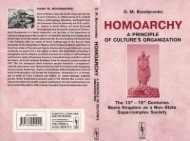L. Fituni, I. Abramova Resource Potential of Africa and Russia's ...
L. Fituni, I. Abramova Resource Potential of Africa and Russia's ...
L. Fituni, I. Abramova Resource Potential of Africa and Russia's ...
Create successful ePaper yourself
Turn your PDF publications into a flip-book with our unique Google optimized e-Paper software.
In was only in the first decade <strong>of</strong> the new Millennium that Moscow<br />
started to resuscitate the old economic <strong>and</strong> political links. There<br />
is still much argument about what was the real cause for the unexpected<br />
revival <strong>of</strong> interest. Was it a self-confident stride und successes<br />
<strong>of</strong> Beijing there, which by that time began to assume the role<br />
model for the Kremlin – the role <strong>of</strong> a de facto leader <strong>of</strong> the BRIC<br />
countries? Or, on the contrary, was it a result <strong>of</strong> a brief “love affair”<br />
between Moscow <strong>and</strong> London at the times <strong>of</strong> preparations for G-8<br />
meetings in Saint-Petersburg <strong>and</strong> Gleneagles?<br />
No matter, what was the cause, too much time <strong>and</strong> too may positions<br />
have been lost. In 2010, Russia’s trade turnover with <strong>Africa</strong><br />
was about 2 billion US dollars, whereas in 1989 (not the best year to<br />
compare with, but the last for which we have reliable foreign trade<br />
statistics) it was nearly 3.4 billion USD. The data are in current<br />
prices. That means that the figure <strong>of</strong> 2 billion refers to inflated contemporary<br />
US currency, while the purchasing power <strong>of</strong> the dollar<br />
twenty years ago was much higher. In fact, 3.4 billion USD in 1989<br />
(domestic US) prices are equal to 5.8 billion USD in 2009 prices.<br />
For comparison, the current volume <strong>of</strong> the Chinese turnover (excluding<br />
Hong Kong) with <strong>Africa</strong> is 10 times higher than the Russian<br />
one.<br />
We have to acknowledge that the shortsightedness <strong>of</strong> some Soviet<br />
<strong>and</strong> post-Soviet politicians resulted in an unprecedented loss <strong>of</strong><br />
achieved gains <strong>of</strong> the Soviet-<strong>Africa</strong>n economic cooperation, the cooperation,<br />
which had been mutually beneficial <strong>and</strong> which, unfortunately,<br />
is still surrounded with huge amounts <strong>of</strong> myths, lies, <strong>and</strong><br />
prejudice. Therefore, having considered the current shortage <strong>of</strong> factual<br />
information on non-ideological aspects <strong>of</strong> Soviet-<strong>Africa</strong>n relations,<br />
we found it expedient to review that cooperation in more detail.<br />
This analysis would allow us to see clearly what has been lost<br />
or squ<strong>and</strong>ered irreversibly, <strong>and</strong> where the last crumbs remain that<br />
can still be used at the current stage <strong>of</strong> Russian-<strong>Africa</strong>n cooperation.<br />
Before the Second World War economic relations between <strong>Africa</strong><br />
<strong>and</strong> the USSR were hardly existent. That does not mean that<br />
<strong>Africa</strong>n commodities never reached the Soviet market in those<br />
years. In fact, a stable inflow <strong>of</strong> such <strong>Africa</strong>n products as cocoa,<br />
132







